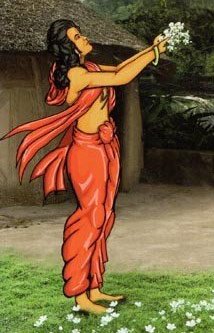Kantika, Kāntīka, Kaṇṭika: 7 definitions
Introduction:
Kantika means something in Hinduism, Sanskrit, Buddhism, Pali. If you want to know the exact meaning, history, etymology or English translation of this term then check out the descriptions on this page. Add your comment or reference to a book if you want to contribute to this summary article.
In Hinduism
Purana and Itihasa (epic history)
Source: JatLand: List of Mahabharata people and placesKāntīka (कान्तीक) is a name mentioned in the Mahābhārata (cf. VI.10.63) and represents one of the many proper names used for people and places. Note: The Mahābhārata (mentioning Kāntīka) is a Sanskrit epic poem consisting of 100,000 ślokas (metrical verses) and is over 2000 years old.

The Purana (पुराण, purāṇas) refers to Sanskrit literature preserving ancient India’s vast cultural history, including historical legends, religious ceremonies, various arts and sciences. The eighteen mahapuranas total over 400,000 shlokas (metrical couplets) and date to at least several centuries BCE.
Kavya (poetry)
Source: OpenEdition books: Vividhatīrthakalpaḥ (Kāvya)Kaṇṭika (कण्टिक) (= Kaṇṭhikā ?) in Sanskrit means “chain”, as is mentioned in the Vividhatīrthakalpa by Jinaprabhasūri (13th century A.D.): an ancient text devoted to various Jaina holy places (tīrthas).—(JOIB XV p. 415 Balbir 1986 p. 66).

Kavya (काव्य, kavya) refers to Sanskrit poetry, a popular ancient Indian tradition of literature. There have been many Sanskrit poets over the ages, hailing from ancient India and beyond. This topic includes mahakavya, or ‘epic poetry’ and natya, or ‘dramatic poetry’.
Languages of India and abroad
Pali-English dictionary
Source: Sutta: The Pali Text Society's Pali-English Dictionary1) Kantika, 2 =kanta1 in a° unpleasant, disgusting Pv III, 41 (=PvA. 193). (Page 186)
2) Kantika, 1 (adj.) (to kantati1) spinning PvA. 75 (sutta° itthiyo). (Page 186)

Pali is the language of the Tipiṭaka, which is the sacred canon of Theravāda Buddhism and contains much of the Buddha’s speech. Closeley related to Sanskrit, both languages are used interchangeably between religions.
Sanskrit dictionary
Source: Cologne Digital Sanskrit Dictionaries: Monier-Williams Sanskrit-English DictionaryKāntika (कान्तिक):—[from kānta] m. [plural] Name of a people, [Viṣṇu-purāṇa]
Source: DDSA: Paia-sadda-mahannavo; a comprehensive Prakrit Hindi dictionary (S)Kaṇṭika (कण्टिक) in the Sanskrit language is related to the Prakrit words: Kaṃṭiyaṃ, Kaṃṭiyā.
[Sanskrit to German]
Sanskrit, also spelled संस्कृतम् (saṃskṛtam), is an ancient language of India commonly seen as the grandmother of the Indo-European language family (even English!). Closely allied with Prakrit and Pali, Sanskrit is more exhaustive in both grammar and terms and has the most extensive collection of literature in the world, greatly surpassing its sister-languages Greek and Latin.
See also (Relevant definitions)
Starts with: Kantikai, Kantikam, Kantikara, Kantikaranja, Kantikari.
Ends with: Aikantika, Amarakantika, Anaikantika, Anekantika, Atikkantika, Civappukkantika, Darakantika, Ekantika, Kshudrakantika, Lokantika, Nishkantika, Odakantika, Okkantika, Sankantika, Sthulakantika, Suttakantika.
Full-text: Kantikam, Sthulakantika, Adharakantaka, Kamtiyam, Jivakantikam, Kamtiya, Nishkantika, Kshudrakantika, Darakantika, Kanthika, Ashtalohaka.
Relevant text
Search found 4 books and stories containing Kantika, Kāntīka, Kāntika, Kaṇṭika, Kaṇṭikā; (plurals include: Kantikas, Kāntīkas, Kāntikas, Kaṇṭikas, Kaṇṭikās). You can also click to the full overview containing English textual excerpts. Below are direct links for the most relevant articles:
The history of Andhra country (1000 AD - 1500 AD) (by Yashoda Devi)
Part 2 - Beta Vijayaditya V (A.D. 925) < [Chapter XI - The Chalukyas]
List of Mahabharata people and places (by Laxman Burdak)
Manikanteesvara Temple: Kani Pakkam < [January – March, 1989]
The Vishnu Purana (by Horace Hayman Wilson)